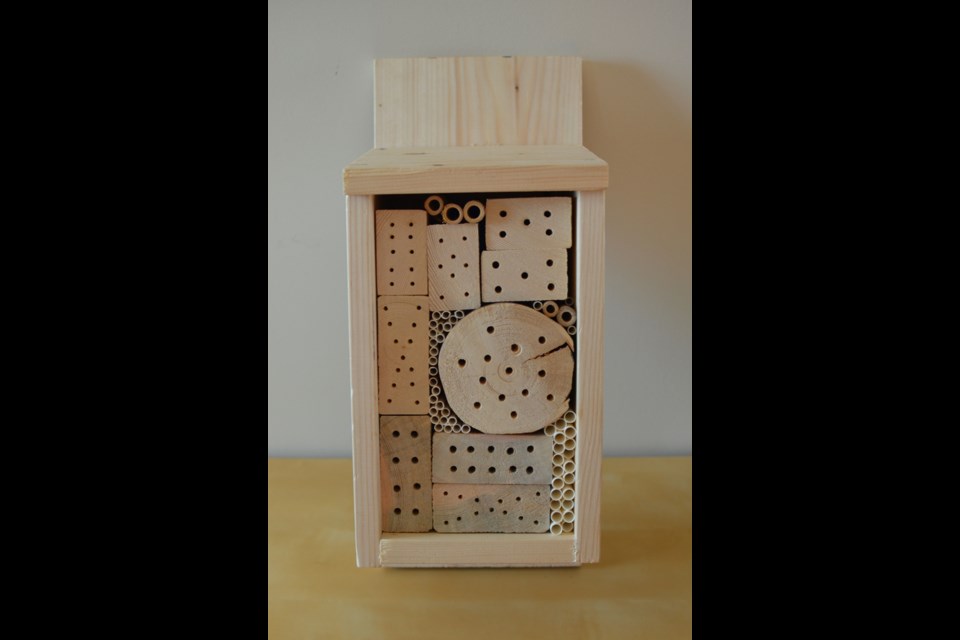Raising honeybees may have transformed into a popular backyard hobby, but home-grown hives actually don't help protect Alberta's expert pollinators.
Alberta is home to more than 300 native species of bees, most of which are solitary, meaning they don't live in a hive and they don't produce wax or honey. These solitary bees may work alone, but they are at least two times better at pollinating plants than honeybees, as their main objective is to collect as much pollen as possible.
However, they are facing a steep uphill battle to survive. Habitat loss due to urban development poses the biggest harm to Alberta's wild bee populations, along with climate change and pesticide use, said Nikki Paskar, conservation co-ordinator with Edmonton and Area Land Trust (EALT).
"We are seeing declines in bee populations, but the data is a little bit more limited for native bees," Paskar said.
The EALT is a conservation organization with the primary focus of securing and stewarding natural areas in the Edmonton region, including Boisvert's GreenWoods, a protected forest north of Morinville.
"What we're seeing is that the declines are directly related to habitat loss, so that's why protected areas, such as EALT's conservation lands, are so important. We need to have these large-scale areas where ecosystems are kept intact."
There are several ways people can help protect pollinator populations, Paskar said: offer them a home in your backyard; support efforts to conserve natural areas; plant the flowers they like; and toss the pesticides. They'll make sure your garden grows beautifully in return.
Bee hotels
Treat Alberta's wild bees to a safe nursery by building bee hotels. Bee hotels attract tunnel-nesting solitary bees, such as sweat bees, and other solitary pollinators by providing them tunnels where they can lay their eggs. They leave them over the winter, and then the bees emerge the following spring.
While some stores carry pre-made bee hotels, Paskar said it's best to make your own because Alberta bees are smaller and need narrower tunnels than what's commercially available.
"When the hotels are constructed and maintained properly, they can be a really great habitat enhancement for many of our native species," Paskar said.
Here's how you can make your own. Use blocks that are made of wood or other permeable material (not bamboo, plastic, metal, or cedar). Make sure you drill a variety of tunnel sizes into the wooden blocks, ranging from one millimetre to nine millimetres. The tunnels should also be drilled back about 15 centimetres in length, so use an extra-long drill bit. Keep the entrance open and the back of the tunnel closed.
Make sure the blocks are removable for cleaning and replacing and there's an overhang over the tunnels to protect them from the elements. Hotels need to be 1.2 metres to 1.5 metres off the ground, either mounted to a fence, tree, or sturdy post. Instead of one big bee condo, it's better for the bees to make multiple smaller ones in different locations.
"For families, it's such a great educational resource for people to engage with nature in their own backyard, especially for kids to see the bees enter the hotel and lay their eggs and then cap (the tunnel), and you can see what they cap it with to determine the species. It's just a very engaging way to connect with nature."
Click here for a full tutorial on how to make your own.
Flowers
The best flowers to plant in your garden for wild bees are the flowers that naturally grow in the province, Paskar said.
"Planting pollinator-friendly flowers is probably the number one thing that people can do," she said. "The more native flowers that you can plant in your garden, the better."
It's also really important to choose a variety of different flower shapes and sizes, especially ones that bloom at different times throughout the year. Some species to consider are Violets or shrubs such as Willows, Saskatoons, or Roses. During the summer, plant Meadow Blazing Star, Gaillardia, Fleabane, and wild Bergamot. In the fall, plant Asters.
If you're planning out your garden or your backyard, just leave a little patch of bare ground for the ground-nesting species, such as plasterer bees and mining bees, so they have a place to lay their eggs, too.
Some alternatives to pesticides when gardening include companion planting (plants that like to live together); bio control, such as using ladybugs for aphids; or rotation planting – planting different species in different areas in your garden each year.



